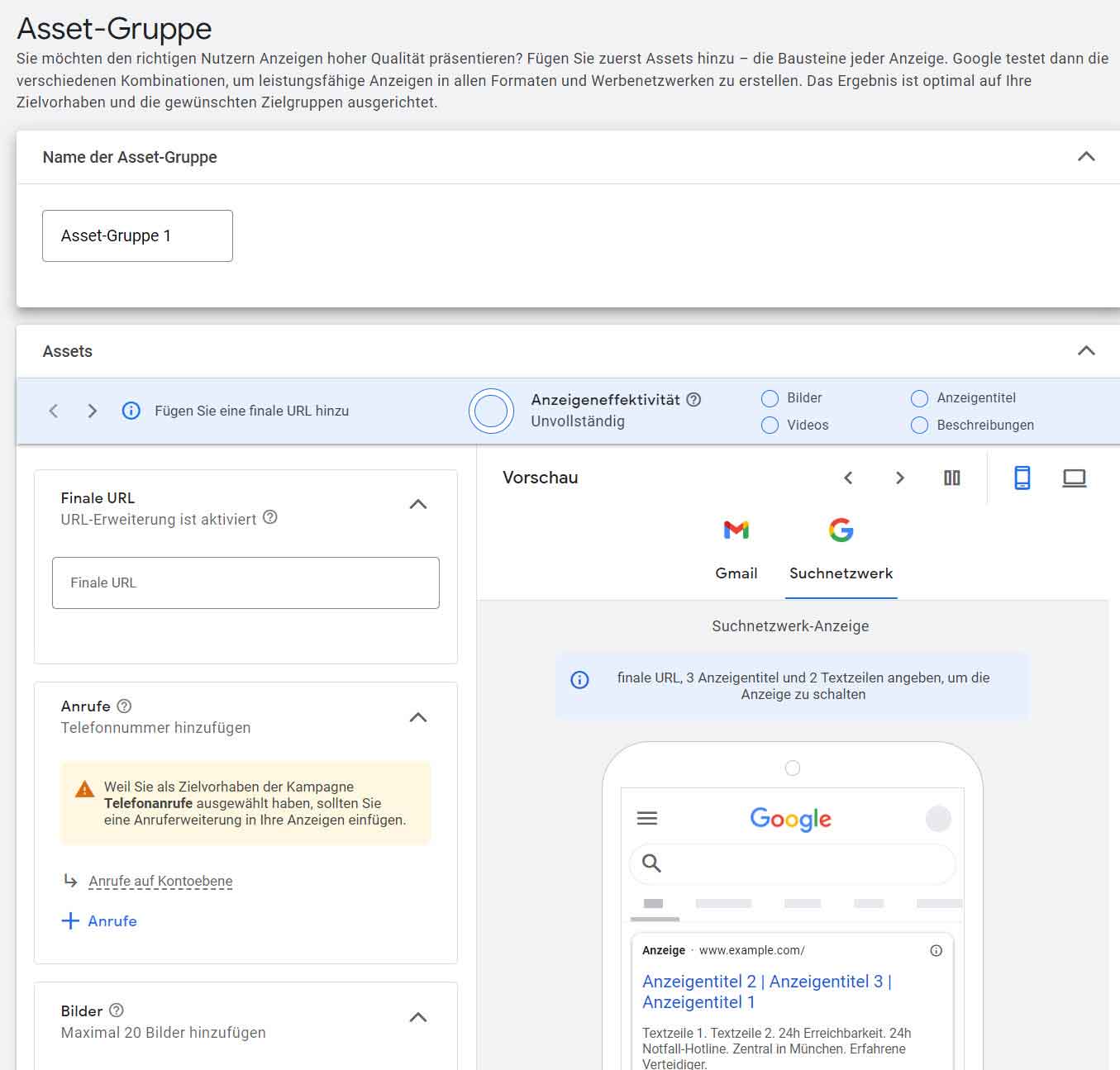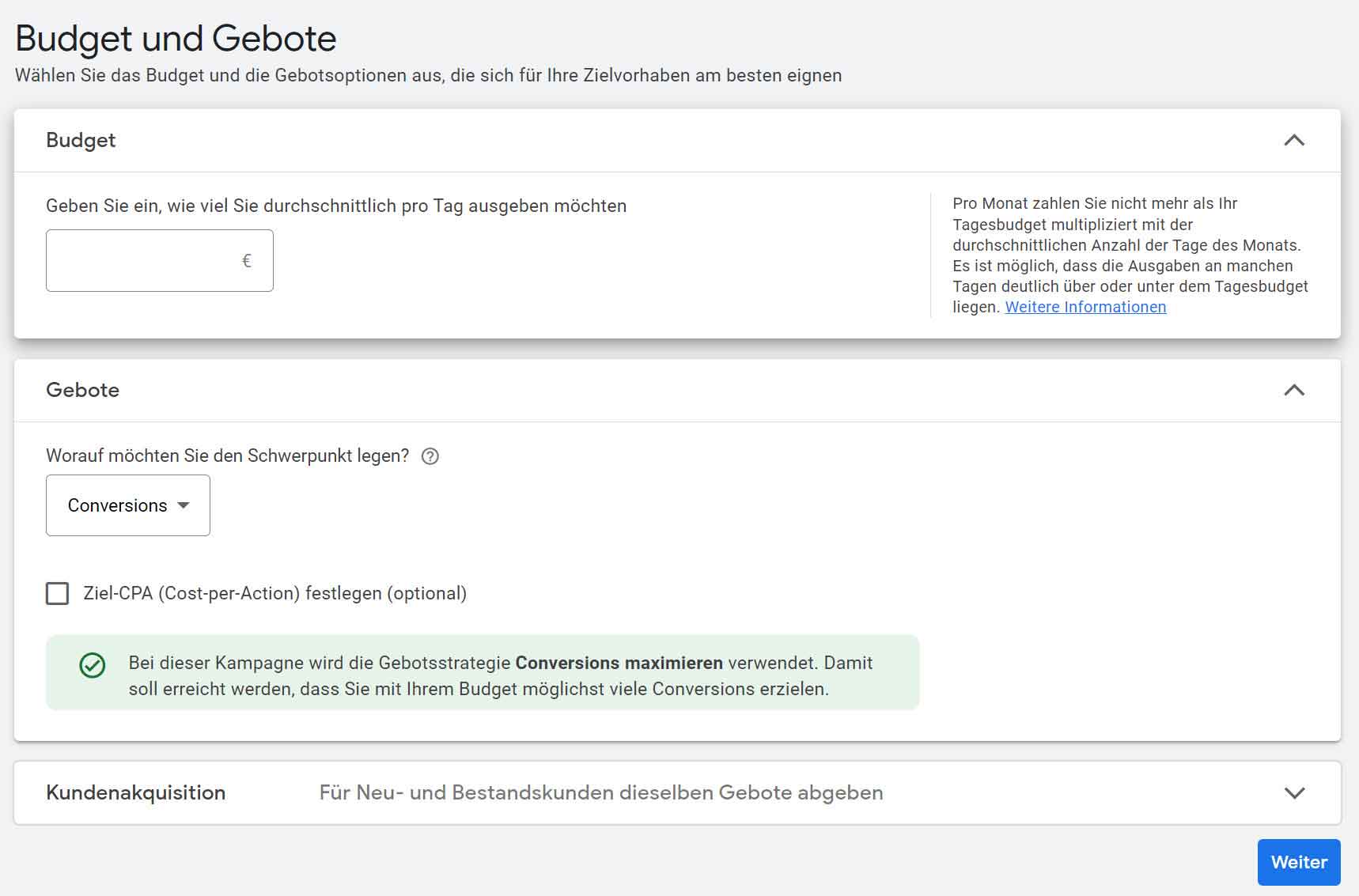Want to maximize the performance of your Google campaigns with even more automation? This is what the new campaign format, the “Performance Max Campaign”, from Google offers you since the end of 2021. It is a fully automated campaign type based on your target intentions. In addition, the target-oriented campaign merges the playout options of the already existing campaign types into one.
In this article, you will learn how you too can benefit from the technical option in Google Ads.
What is a Performance Max campaign?
With Google’s new campaign format, called “Performance Max” or “Maximum Performance,” Google aims to further optimize and simplify the advertising space. The algorithm plays an essential role in this. It makes the creation of campaigns and ads almost automated. The playout options of the various campaign types such as the search network, the YouTube advertising network, Google Shopping, Google Discover and Google Maps are combined accordingly and played in a so-called Performance Max campaign.
Novelties through Performance Max campaigns
The Performance Max campaign features two major innovations in the way it works. On the one hand, there are the automated ad groups, called asset groups, and on the other hand, there is an innovation in automated targeting, in the form of target group signals.
Instead of the ad groups known from the older campaign types, Google relies on asset groups in the Performance Max campaign. An asset group is composed of different asset types, such as image assets, video assets, and text assets. For example, a text asset can consist of a description, an ad title, or a call-to-action.
Smart bidding enables real-time bid optimization and better results across channels. Automation technologies available from Google are used for bidding, budget optimization, targeting, creatives and attribution, among others.

Context-based search and displays
Away from keyword-based search to context-based search – this is the step Google wants to take with this campaign type. Ads are no longer played out based on keywords alone, but are delivered through user signals defined by the algorithm. Essential keywords can be included in the campaign settings to provide guidance to the algorithm. In this way, a Performance Max campaign, as a complement to the keyword-based search campaign, can help reach more customers.
The algorithm’s task is to segment people in the target group in detail according to their buying interest and then to play the appropriate ad to this target group at the right time in the customer journey.
With the help of the algorithm, the ad assets provided by the advertiser (consisting of image, video and text modules) are adapted to the potential customer in the corresponding channel and played out.
The goal is to achieve more conversions and a higher conversion value based on the conversion target. Correct conversion tracking setup is a prerequisite for this. Optimizations are supported based on the specific advertising target (e.g. CPA or ROAS target). Additions of important target group signals, as well as high-quality images, texts and videos, can further improve campaign performance.
Different bidding strategies – Which is the right one?
In the campaign settings, you can specify which bidding strategy you want to use to optimize your campaign.
- Conversion Value Maximization
- Conversion count
- ROAS Target
Conversion value maximization is useful if you want to achieve a high shopping cart value and generate a lot of sales.
A high number of conversions can be optimized for if the goal is to receive many inquiries, all of which are basically worth the same amount to begin with.
The last option, optimization for ROAS, makes it possible to optimize costs in relation to conversions (ROAS – “return on ad spend”, describes the ratio between profit achieved and the cost of the campaign). A ROAS target is defined. This simultaneously determines how much revenue/value is to be generated per euro invested. The higher the ROAS in active campaigns, the more successful the campaign basically runs. It is important not to set the ROAS too high at the beginning, as this can limit the targeting of the ads. Campaigns already underway could be helpful here to provide a benchmark for a meaningful ROAS.
Setting options for Performance Max campaigns
You are responsible for the content of the ads. Thus, it is your task to create various assets. In a campaign it is possible to create several asset groups, for example for different product groups.
In the assets are created:
- Headlines
- long ad title
- Descriptions
- Images
- Logos
- YouTube videos
- Ad extensions
Assets are the heart of a campaign and should therefore be well thought out. Individual components can be replaced or deleted at any time.
- You can also use the “Extend final URL” function here. This extracts ad text, text lines, and other assets from appropriate target URLs and adjusts them accordingly if Google sees them as improving performance. However, this function can also be completely disabled or exclude certain URLs.
- Negative keywords can be excluded so that the ad is not played for certain search queries.
- Existing target group signals should definitely be used. Here, existing customer lists can be used or user-defined segments can be created. Although Google will not adhere to these target group signals exclusively, it does provide the algorithm with initial guidelines for optimal playout.
- The geographic as well as temporal orientation of the campaign can be controlled
- Take a look at where your ads have been placed. However, precise data on the performance of the individual placements is not possible at present.

Advantages of a Performance Max campaign
- This type of campaign basically benefits greatly from conversion optimization. Since all Google channels are served in one campaign, potential customers can be reached at any time.
- Google’s machine learning and artificial intelligence can be used to target previously unknown customer segments. Google works with real-time data and strategies based on data from customers. No matter how good an account manager is, no human employee can replicate that.
- Through machine learning, Google is getting better at predicting which campaign and which combination of ads will get the best results for which audience. Thanks to data-based attribution across all Google channels, the most promising touchpoint is automatically optimized.
- Automation can make work easier or at least shift work to the strategic and holistic area.
Disadvantages of a Performance Max campaign
- The target group targeting only serves as an orientation for the Google algorithm. Targeted containment and exclusion are no longer possible. Google decides on the exact targeting of the campaign itself.
- There is limited visibility into performance data. What exactly contributed to the performance of the Google campaign and to what extent remains largely hidden
- Time! Machine learning and teaching artificial intelligence for automation to work takes a long learning period. For this reason, a Performance Max campaign is rather unsuitable for certain topics.
- There is almost no possibility to make adjustments manually.
- Little control over how exactly the asset components are put together in the Ads. For this reason, it is important to take care when creating assets that all asset details are compatible with each other.
Who is a Performance Max campaign suitable for?
The main purpose of a Performance Max campaign is to generate leads and increase online and offline sales.
Also, creating a Performance Max campaign is suitable for advertisers who already have large amounts of data available in their account. If this is not the case, a lot of time is taken until the algorithm is optimized accordingly.
It is difficult to manually find the appropriate keywords for the relevant industry? The topic is not typically searched on Google or it is a niche product? Then test out the Performance Max campaign. The algorithm will help to target the right audience.
Want to achieve visibility on Google’s various channels with just one campaign? A Performance Max campaign is also suitable here.
4 Best practice on asset groups
More tips for creating a Performance Max campaign
- Let the campaign run for some time first. The more data available, the better results can be achieved using machine learning. The use of remarketing lists, custom audiences with common intent, customer matching, and similar audiences as signals are all suitable.
- With the “maximize conversion” or “target CPA” bidding strategy, it makes sense to select a conversion action at the bottom of the funnel that is executed frequently, such as qualified leads or leads with conversion. You should also set the target CPA. Other target projects should be marked “Observation only”. If only a few conversions have been achieved after a few months, a target project in the upper funnel range should be considered.
- The bidding strategy Conversion Value and Target ROAS are particularly suitable in the e-commerce sector and for accounts that have already generated a lot of data. The current ROAS should be read out in advance on the basis of the last few months and reassessed with a +10-20% increase.
- To attract more customers, it is recommended to provide multiple asset groups to create more ad formats for different channels and users. Linking the right target group signals and the right assets achieve the best results. Unique content that appeals to the target audience can be combined into one asset to create the right ad for the target audience.
- It is important to structure the asset groups sensibly and not to create too many asset groups. For example, one asset group could be created on all products, another on the target group with the best audience signals, and one on sales.
- Continuous optimization of creatives is the best way to keep improving performance. It is recommended to look at the details of the asset groups at least once a week and to exchange creatives with low performance.
- Important keywords should be included in the target group settings. These keywords provide the algorithm with support for the correct delivery, but are only taken as a guide and extended as desired.
- A separate campaign should be created for each clearly definable target group, since the algorithm combines the various assets with each other and no clear structure can be created for different target groups in one campaign.







